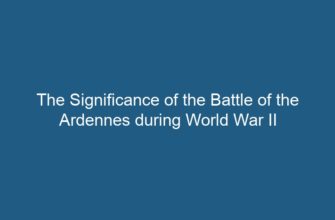The Battle of Yorktown, which took place from September 28 to October 19, 1781, was a decisive victory for the American colonists during the American Revolutionary War. This battle marked the culmination of a series of events that led to the eventual independence of the United States from British rule. In this article, we will explore the reasons why the Americans emerged victorious at Yorktown, examining various factors that contributed to their success.
- 1. Strategic Location
- 2. French Support
- 2.1 French Naval Blockade
- 2.1.1 French Fleet Superiority
- History Brief: The Battle of Yorktown
- The US Victory at Yorktown Births a Nation | The Revolution (S1, E11) | Full Episode
- 3. Leadership and Strategy
- 3.1 Siege Tactics
- 3.1.1 The Surrender of Cornwallis
- 4. British Mistakes
- 4.1 Failure to Reinforce
- 4.1.1 Misjudgment of the Situation
- 5. Conclusion
- FAQs
- FAQ 1: How did the French support the Americans at Yorktown?
- FAQ 2: What was the significance of the French naval blockade?
- FAQ 3: How did the American and French forces employ siege tactics at Yorktown?
- FAQ 4: What mistakes did the British make at Yorktown?
- FAQ 5: How did the surrender of Cornwallis impact the war?
- FAQ 6: Why was the Battle of Yorktown important in American history?
- Conclusion
1. Strategic Location
One of the key factors that played a significant role in the American victory at Yorktown was the strategic location of the battlefield. Situated on the Virginia Peninsula, Yorktown provided the Americans with several advantages. It was a defensible position, surrounded by water on three sides, making it difficult for the British to launch a full-scale assault. The proximity of the Chesapeake Bay also allowed for easier access to French naval support, which proved crucial in the outcome of the battle.
2. French Support
The assistance provided by the French was instrumental in the American victory at Yorktown. Under the leadership of General Jean-Baptiste de Rochambeau, a contingent of French soldiers arrived in North America to aid the American colonists. The French fleet, commanded by Admiral François Joseph Paul de Grasse, played a crucial role in preventing the British from escaping by sea. The combined forces of the Americans and the French outnumbered the British, giving them a significant advantage on the battlefield.
2.1 French Naval Blockade
The French naval blockade was an essential component of the American victory at Yorktown. By preventing the British fleet from reinforcing or evacuating their troops, the French effectively cut off any potential escape routes for the British forces. This blockade not only limited the British options but also instilled a sense of desperation and demoralization among their ranks.
2.1.1 French Fleet Superiority
The French fleet’s superiority over the British navy was a decisive factor in the success of the blockade. The French had a larger and more powerful fleet, which allowed them to control the waters surrounding Yorktown effectively. This prevented the British from receiving reinforcements or supplies, ultimately weakening their position and morale.
History Brief: The Battle of Yorktown
The US Victory at Yorktown Births a Nation | The Revolution (S1, E11) | Full Episode
3. Leadership and Strategy
The leadership and strategic decisions made by the American and French commanders significantly contributed to the victory at Yorktown. General George Washington, along with his French counterpart General Rochambeau, devised a plan to trap the British forces at Yorktown. They decided to launch a joint land and naval assault, utilizing the advantages of their combined forces and the strategic positioning of the battlefield.
3.1 Siege Tactics
The American and French forces successfully employed siege tactics to surround and isolate the British army at Yorktown. They constructed a series of fortifications, including trenches and redoubts, to cut off the British from any potential reinforcements or escape routes. This forced the British into a defensive position, unable to break out or receive support.
3.1.1 The Surrender of Cornwallis
The relentless bombardment and the deteriorating situation led British General Charles Cornwallis to surrender on October 19, 1781. The successful execution of the siege tactics by the American and French forces left Cornwallis with no choice but to capitulate. This surrender marked a significant turning point in the war and ultimately led to the recognition of American independence.
4. British Mistakes
Several mistakes made by the British also contributed to their defeat at Yorktown. These errors further weakened their position and ultimately led to their surrender.
4.1 Failure to Reinforce
The British failed to reinforce their troops at Yorktown, despite receiving intelligence about the impending American and French assault. The lack of reinforcements left the British forces at a numerical disadvantage, making it difficult for them to withstand the combined assault of the American and French armies.
4.1.1 Misjudgment of the Situation
British General Cornwallis misjudged the strength and determination of the American and French forces. He believed that the British navy would be able to break the French naval blockade and provide the necessary reinforcements. This miscalculation ultimately proved fatal and led to the surrender of his forces.
5. Conclusion
The American victory at the Battle of Yorktown was the result of a combination of factors, including the strategic location, French support, leadership and strategy, and the mistakes made by the British. The Americans and the French effectively utilized their advantages and successfully executed their plan, leading to the surrender of the British forces. This decisive victory marked a turning point in the American Revolutionary War and paved the way for the eventual independence of the United States.
FAQs
FAQ 1: How did the French support the Americans at Yorktown?
The French provided both military and naval support to the Americans at Yorktown. Under the command of General Rochambeau, a contingent of French soldiers arrived in North America to aid the American colonists. The French fleet, commanded by Admiral de Grasse, played a crucial role in preventing the British from escaping by sea.
FAQ 2: What was the significance of the French naval blockade?
The French naval blockade prevented the British from receiving reinforcements or supplies and cut off any potential escape routes. This blockade weakened the British position and demoralized their troops, ultimately contributing to their defeat at Yorktown.
FAQ 3: How did the American and French forces employ siege tactics at Yorktown?
The American and French forces constructed fortifications, including trenches and redoubts, to surround and isolate the British army at Yorktown. These siege tactics cut off the British from potential reinforcements or escape routes, forcing them into a defensive position.
FAQ 4: What mistakes did the British make at Yorktown?
The British made several mistakes at Yorktown, including failing to reinforce their troops despite receiving intelligence about the impending assault. British General Cornwallis also misjudged the strength and determination of the American and French forces, believing that the British navy would be able to break the French blockade.
FAQ 5: How did the surrender of Cornwallis impact the war?
The surrender of Cornwallis at Yorktown marked a significant turning point in the war. It led to the recognition of American independence and ultimately paved the way for the end of the American Revolutionary War.
FAQ 6: Why was the Battle of Yorktown important in American history?
The Battle of Yorktown was important in American history as it marked a decisive victory for the American colonists and contributed to the eventual independence of the United States. It demonstrated the effectiveness of American and French cooperation and brought an end to major military operations in the Revolutionary War.
Conclusion
The Battle of Yorktown was a critical turning point in the American Revolutionary War. The strategic location, French support, leadership and strategy, and the mistakes made by the British all played significant roles in the American victory. This triumph led to the recognition of American independence and set the stage for the birth of a new nation. The Battle of Yorktown remains a testament to the determination and perseverance of the American colonists, forever etched in the annals of American history.










